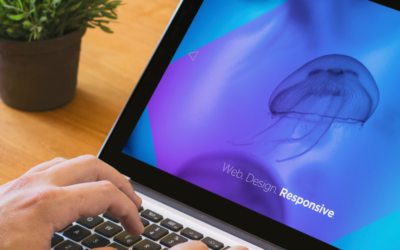Typography Tips for Websites
Adopt these Best Practices![]() by jasmine malia
by jasmine malia
Navigating Design Basics
Selecting font for your website can be exciting with the seemingly endless possibilities available. It can also be a bit tricky to make sure it looks great and is user-friendly on your website.
There are a lot of things to consider when designing for the screen, and as technology and products advance, the conditions to design will continuously shift. However, when it comes to website typography, there are certain things that seem to always hold true.
Following some proven expert best practices when selecting font or adding text to your website will enhance your website users’ experience, ensuring it is both valuable and memorable.

Keep Your Font Family Small
Sans serif fonts are associated with a clean and minimalist design. If you use more than 3 fonts in your design, it can lose its professionalism and might disrupt the layout. A limited number of fonts maintains visual cohesion throughout your website and makes it look consistent and aesthetically pleasing.
● Make sure multiple fonts complement each other
● It is to best use variations of the same typeface
Stick to Limited Colors
Overusing colors in your text can be distracting and even make the text harder to read. Users may also mistake over-designed text for adverts. By limiting your colors choices, you create a visually appealing and easy-to-read experience for your visitors. Don’t be afraid of using color though, just be smart about it.
● Avoid blue for body text, users associate it with links
● Using 4 different colors or less is recommended
Prioritize San Serif Fonts
Sans serif fonts are associated with a clean and minimalist design aesthetic, which aligns with most modern websites. They can be easily integrated into various design styles and branding concepts and are often recommended for users with visual impairments as they are easier to distinguish.
● Consider reserving serif fonts for headings + accents
Embrace White Space
Multiple studies have revealed that people who read text with margins found it easier to read and understand what they were reading. Spaces between paragraphs and spreading out the content delivers the information in a digestible format that encourages users to continue reading.
● Spacing letters improves readability for users
● Maintain consistent spacing across your site
Prioritize San Serif Fonts
Sans serif fonts are associated with a clean and minimalist design aesthetic, which aligns with most modern websites. They can be easily integrated into various design styles and branding concepts and are often recommended for users with visual impairments as they are easier to distinguish.
● Consider reserving serif fonts for headings + accents
Enrace White Space
Multiple studies have revealed that people who read text with margins found it easier to read and understand what they were reading. Spaces between paragraphs and spreading out the content delivers the information in a digestible format that encourages users to continue reading.
● Maintain consistent spacing across your site
Keep Your Font Family Small
Sans serif fonts are associated with a clean and minimalist design. If you use more than 3 fonts in your design, it can lose its professionalism and might disrupt the layout. A limited number of fonts maintains visual cohesion throughout your website and makes it look consistent and aesthetically pleasing.
● Make sure multiple fonts complement each other
● It is to best use variations of the same typeface
Stick to Limited Colors
Overusing colors in your text can be distracting and even make the text harder to read. Users may also mistake over-designed text for adverts. By limiting your colors choices, you create a visually appealing and easy-to-read experience for your visitors. Don’t be afraid of using color though, just be smart about it.
● Avoid blue for body text, users associate it with links
● Using 4 different colors or less is recommended
Prioritize San Serif Fonts
Sans serif fonts are associated with a clean and minimalist design. If you use more than 3 fonts in your design, it can lose its professionalism and might disrupt the layout. A limited number of fonts maintains visual cohesion throughout your website and makes it look consistent and aesthetically pleasing.
● Sans serif fonts are easier to read on all screen sizes
● Consider reserving serif fonts for headings + accents
Embrace White Space
Multiple studies have revealed that people who read text with margins found it easier to read and understand what they were reading. Spaces between paragraphs and spreading out the content delivers the information in a digestible format that encourages users to continue reading.
● Maintain consistent spacing across your site
● Spacing letters improves readability for users
Avoid Flashing Text
Online content that flashes or blinks can cause seizures for some people, and should be purposefully avoided. This includes images as well as text. In addition to possibly causing seizures, flashing and blinking text can be distracting for users.
● Flashing text can be difficult to read
● Try using a bright pop of color instead
Use Standard Fonts
Web-safe fonts are proven as easy to read through any digital means. They render on every browser, and viewers recognize them instantly which helps them scan the content more quickly. They have fewer instances of similar glyphs such as “I” and “l”.
● Web-safe fonts usually lack design flaws
● These fonts are equally readable at 10px as at 72px
Do Your Research!
Your website’s typography reflects your brand. Invest time in researching fonts that align with your brand identity and resonate with your target audience. Before making any decisions, always conduct thorough research on font pairings, ensuring they complement each other and create a harmonious visual experience. Finally, consider accessibility guidelines to make your website inclusive and user-friendly for everyone. Typography plays a vital role in the success of your website. Don’t underestimate its impact!
article by![]() jasmine malia
jasmine malia
SHARE THIS ARTICLE
RELATED ARTICLES
© 2024 Studio Jasmine Malia llc | All rights reserved




